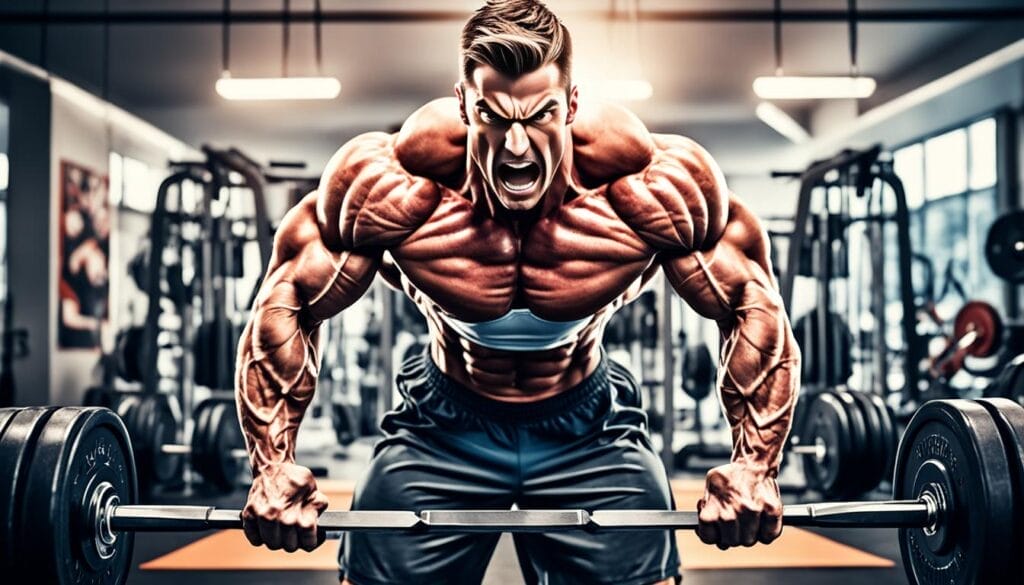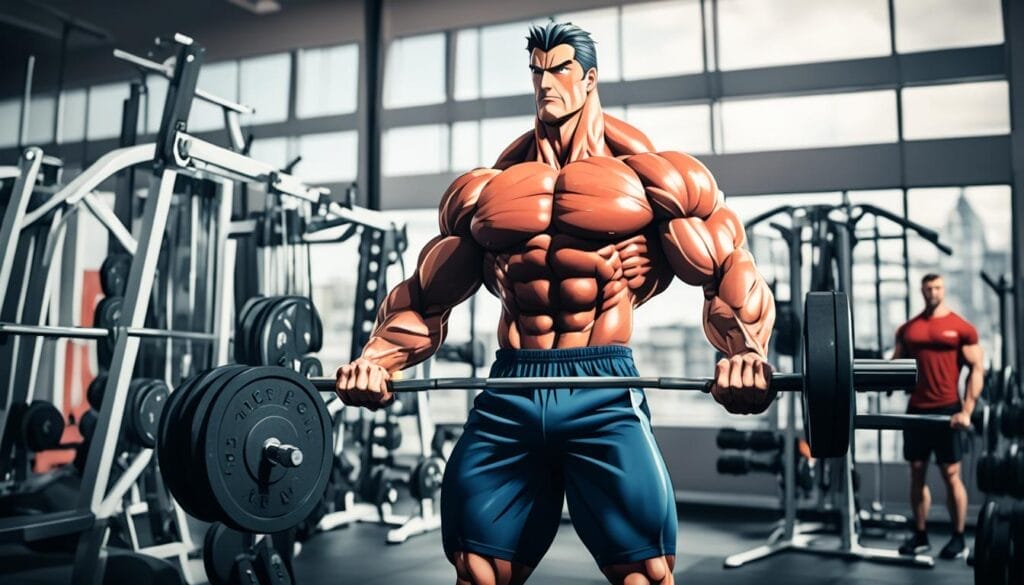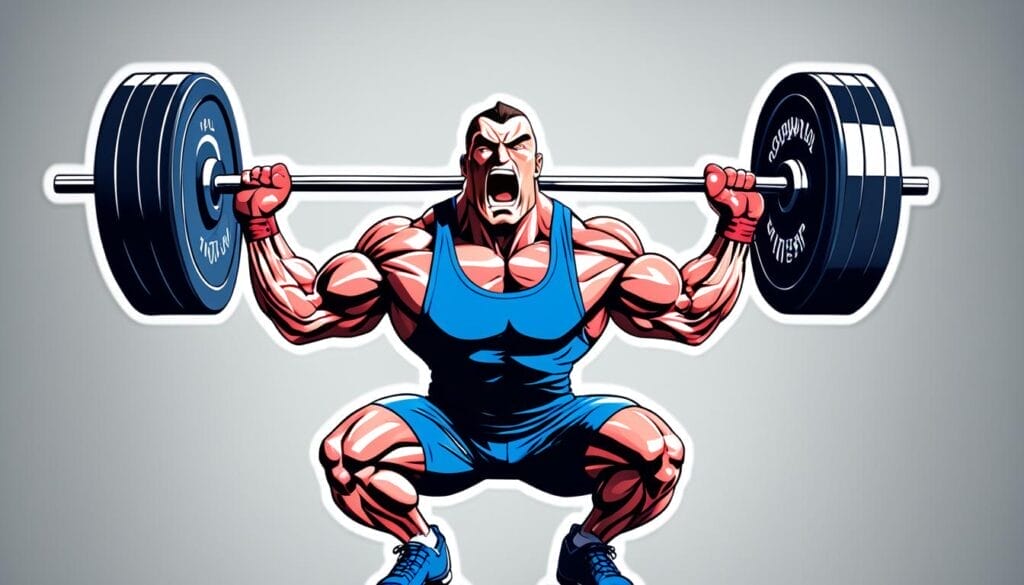Hi fitness fans! Let’s chat about muscle hypertrophy. Even if I’m not a bodybuilder, I find the science behind muscle size intriguing. Whether you’re new to lifting or a seasoned pro, knowing how muscle hypertrophy works can benefit you. It helps in reaching your fitness goals.
I’ll start with a story about my muscle growth journey. Last year, I decided to focus on building mass. I wanted a new challenge and aimed to push my muscles to their limit. I started intense strength and hypertrophy training.
Initially, I felt overwhelmed. There was a lot of conflicting advice and endless gym debates. But I was eager to learn. I read articles, watched tutorials, and talked to experts.
As I learned more, things became clearer. I discovered about myofibrillar and sarcoplasmic hypertrophy. Myofibrillar is for strength, while sarcoplasmic is for endurance. I adjusted my workouts to focus on both.
Though it was tough, I kept pushing. There were days when continuing seemed impossible. But I stayed focused on my goals, pushed through, and prioritised rest. Slowly, I saw changes.
After months, my muscles got bigger and stronger. Friends noticed, and gym-goers even praised my progress. It felt fantastic to see my hard work pay off.
If muscle growth is your goal, keep reading. We’ll explore the science of hypertrophy and share tips to enhance your workouts. We’ll look at types of growth, training, and lifting methods. It’s all coming up.
Key Takeaways:
- Muscle hypertrophy refers to muscle cell growth.
- There are two kinds: myofibrillar (for strength) and sarcoplasmic (for endurance).
- Weightlifting is a great way to boost muscle growth.
- It’s vital to challenge muscles and then let them recover properly.
- Being consistent with workouts, using the right techniques, and changing things up help achieve hypertrophy.
What is Muscular Hypertrophy and How Does it Work?
Muscular hypertrophy is all about muscle cells growing in size. It happens when muscles respond to certain activities like lifting weights. This growth and change build stronger muscles.
There are two kinds of muscle growth. Myofibrillar hypertrophy makes our myofibrils, the muscle’s powerhouse, bigger and stronger. This means more strength and speed. On the flip side, sarcoplasmic hypertrophy expands our muscle’s fluid, boosting endurance and storing more fuel.
So, how do we get muscles to grow?
Weightlifting is a top choice. It puts our muscles under tension and strain, breaking them down slightly. This damage kicks off a rebuild process, making the muscles not only recover but also grow stronger. Weightlifting also uses up the muscles’ energy fast, pushing them to adapt and become bigger.
The way we lift weights affects what type of growth we see. Doing more reps with lighter weights favours growing the fluid and enduring power of our muscles. Lifting heavier weights fewer times builds muscle strength and explosive power. But remember, both kinds of growth can happen at once, just in different amounts.
To really define your muscles, balancing these two growth types is key. A smart workout mixes heavy and light weights, different reps, and always challenges the body to do more. This approach, called progressive overload, slowly makes workouts tougher by either upping the weight or the reps.
Building Muscle and Increasing Muscle Size
Lifting weights is crucial for building muscle. When you lift something heavy, your muscle proteins work harder. They do this to move the weight. This action can damage muscles slightly, making them repair and grow larger. So, don’t be afraid to push your muscles. But, remember, they need time to recover properly too.
Weightlifting is a great way to add muscle. It makes the proteins in your muscles move, trying to lift the heavy weight. This process can make tiny tears in the muscles. But, this is a good thing. This damage tells the body to fix the muscle, making it bigger. It’s like a repair and grow process.
After lifting, muscles might feel tired and lacking energy. This is because they use up their quick energy source, ATP. When this happens, it shows muscles have been worked hard. They then need time to rest and recover.

Lifting heavier weights with the right intensity challenges your muscles. This challenge makes them adapt and grow. Importantly, give your muscles time to rest. This is when they actually grow. So, a balance of hard work and proper rest is key.
Prioritising Strength Training
Working with weights helps create bigger muscles. Doing fewer lifts with heavy weights is the best approach. This training method stresses the muscles more, helping them grow.
As you get stronger, you should lift heavier weights too. This gradual increase in challenge is how muscles keep growing. It’s all about pushing but not overdoing it.
“Weight lifting is an effective method for building muscle and increasing muscle size. By lifting heavy weights, you activate the contractile proteins in your muscles, which generate force to overcome the resistance.”
– Simon Gomm, Professional Trainer
Creating the Right Recovery Environment
For muscles to get bigger, they must be both worked and rested. Make sure to take breaks between workouts. This helps muscles to repair and grow stronger.
Having days off from lifting weights is advised. These rest days are as important as the workout days. They prevent muscle overuse and lower injury chances.
How Often Should You Lift for Muscle Hypertrophy?
The amount you should lift for muscle growth changes based on what you want and your fitness level. It’s key to find the right balance for improving muscle size but still letting them recover. Here are a few ways to do this:
Lifting Heavy Weights Three Days a Week
Lifting heavy weights three times weekly works well for many. A day of rest between each session is essential. This method helps your muscles rebuild. It also ensures you stimulate muscle growth by working hard but not overdoing it.
Lifting Weights Two Days a Week
For a lighter schedule, try lifting weights just twice weekly. This can suit those starting out or people with busy schedules. Focus on keeping your workouts intense to still encourage muscle growth.
Alternating Upper-Body and Lower-Body Lifting
You might pick to work upper-body and lower-body on different days. This way, all muscle groups get attention while having enough time to recover. Mixing up your workouts can lead to balanced muscle growth all over.
Think about how much you lift carefully, and watch signs of too much. Muscle growth happens when you rest well. Also, eating right and getting enough sleep are as important as the exercise itself.
Getting your training schedule right is crucial for building muscle. You need to work hard but give your muscles time to heal for the best outcome.
| Training Frequency | Advantages | Considerations |
|---|---|---|
| Lifting Heavy Weights Three Days a Week | – Allows for sufficient muscle recovery – Stimulates muscle growth and hypertrophy | – Requires dedicated training days – May be less time-efficient |
| Lifting Weights Two Days a Week | – Suitable for beginners or individuals with limited time – Can still promote muscle growth with proper intensity | – Less frequent weightlifting sessions – Must maintain high intensity during workouts |
| Alternating Upper-Body and Lower-Body Lifting | – Targets different muscle groups – Allows for adequate rest and recovery | – Requires careful planning for balanced training – Proper recovery between sessions is crucial |
Tips for Maximising Your Workouts for Muscle Hypertrophy
Want bigger muscles? Several tips can boost your workouts. These strategies will help you get the most out of your routine. You’ll see more muscle and better shape.
1. Reps and Rest
Try a back-and-forth of reps and rests for big muscles. Shoot for 6-12 reps in each set, really tiring out your muscles. This pushes your muscles to grow and become bigger. Remember to rest long enough between sets for full muscle recovery.
2. Lift Enough Weight
To get big muscles, you must lift heavy. Choose weights that make 6-12 reps tough but possible. As you get stronger, add more weight. This keeps your muscles growing and progressing.
3. Vary Exercises
Mix up your workouts. Don’t do the same exercises each time. Changing it up activates different muscle fibres. Mix compound moves like squats with isolations like bicep curls. This variety keeps your muscles guessing and prevents them from getting used to the same routine.
4. Working with a Trainer
Training with an expert can make a big difference. A good trainer shapes a workout just for you. They correct your form, check your progress, and tweak your routine. This support is key to reaching your muscle goals.
Consistency is everything for muscle growth. Always push your muscles but in the right way. Avoid weight that’s too light or too heavy too soon. Stick to these basics and watch your muscles grow.
| Tips for Maximising Your Workouts for Muscle Hypertrophy |
|---|
| Use a reps-and-rest cycle |
| Lift enough weight to challenge your muscles |
| Vary your exercises to target different muscle fibres |
| Consider working with a certified trainer |
Myostatin-Related Muscular Hypertrophy
Myostatin-Related Muscular Hypertrophy is a unique genetic condition. It makes people have less body fat and larger muscles. They are very strong and don’t often face health problems.
This issue happens because of changes in the MSTN gene. This gene controls how muscles grow. With these changes, myostatin, a protein that usually stops too much muscle growth, does not work as it should. This lets muscles grow a lot.
Doctors find this condition through genetic tests. These tests show the gene changes. If you think you might have this, talk to a doctor. They can guide you on what to do.
People with this condition can have big and strong muscles without working out a lot. But, having big muscles doesn’t always mean they are better at sports. Or that they are overall fitter or healthier.

Learning about Myostatin-Related Muscular Hypertrophy is interesting. It shows the complex link between genes and muscle growth. This condition teaches us a lot about how our bodies work.
Summing It All Up...
You can get bigger muscles by lifting weights and paying attention to how you work out. It’s about keeping your muscles challenged and allowing them to recover well. Doing this helps your muscles grow more and look more defined.
To work out in a way that boosts muscle growth, consider some important tips. Use a particular cycle for your sets and rest times. Make sure you’re lifting weights that are heavy for you. Change the exercises you do. And, having a trainer can really help you get your workout plan right. Remember, finding the sweet spot of pushing yourself hard but not too hard is key.
Remember, some people might naturally have bigger muscles due to special genetic conditions. A condition called myostatin-related muscular hypertrophy allows for this. It might not need exercise to show its effects, but it’s something to think about when trying to gain muscle. It’s important to know about all factors that could play a part.
FAQ
What is muscular hypertrophy?
Muscular hypertrophy means the growth of muscle cells.
What are the two types of muscular hypertrophy?
There are two kinds: myofibrillar and sarcoplasmic.
How does myofibrillar hypertrophy differ from sarcoplasmic hypertrophy?
Myofibrillar hypertrophy makes muscle parts bigger for strength and speed. Sarcoplasmic hypertrophy stores more glycogen for lasting endurance.
How does weightlifting contribute to muscle growth?
Weightlifting damages muscles, making them grow bigger when they heal. It also makes muscles use up their energy fast, leading to growth.
How often should I lift weights for muscle hypertrophy?
Weightlifting for muscle growth depends on what you want and how fit you are. You might lift heavy weights three times weekly, resting in between.
What are some tips for maximising workouts for muscle hypertrophy?
To maximise muscle growth, aim for 6-12 reps with proper rest. Make sure you lift weights that challenge you. Change your exercises often to work all muscle types. Lastly, work with a trained professional for the best results.
What is myostatin-related muscular hypertrophy?
It is a rare condition where the body has less fat and more muscle without exercising much.
Source Links
Share Me:
READY TO UNLEASH
YOUR BEST SELF?
Click “Sign Me Up!” And Start Your Fitness Transformation!





